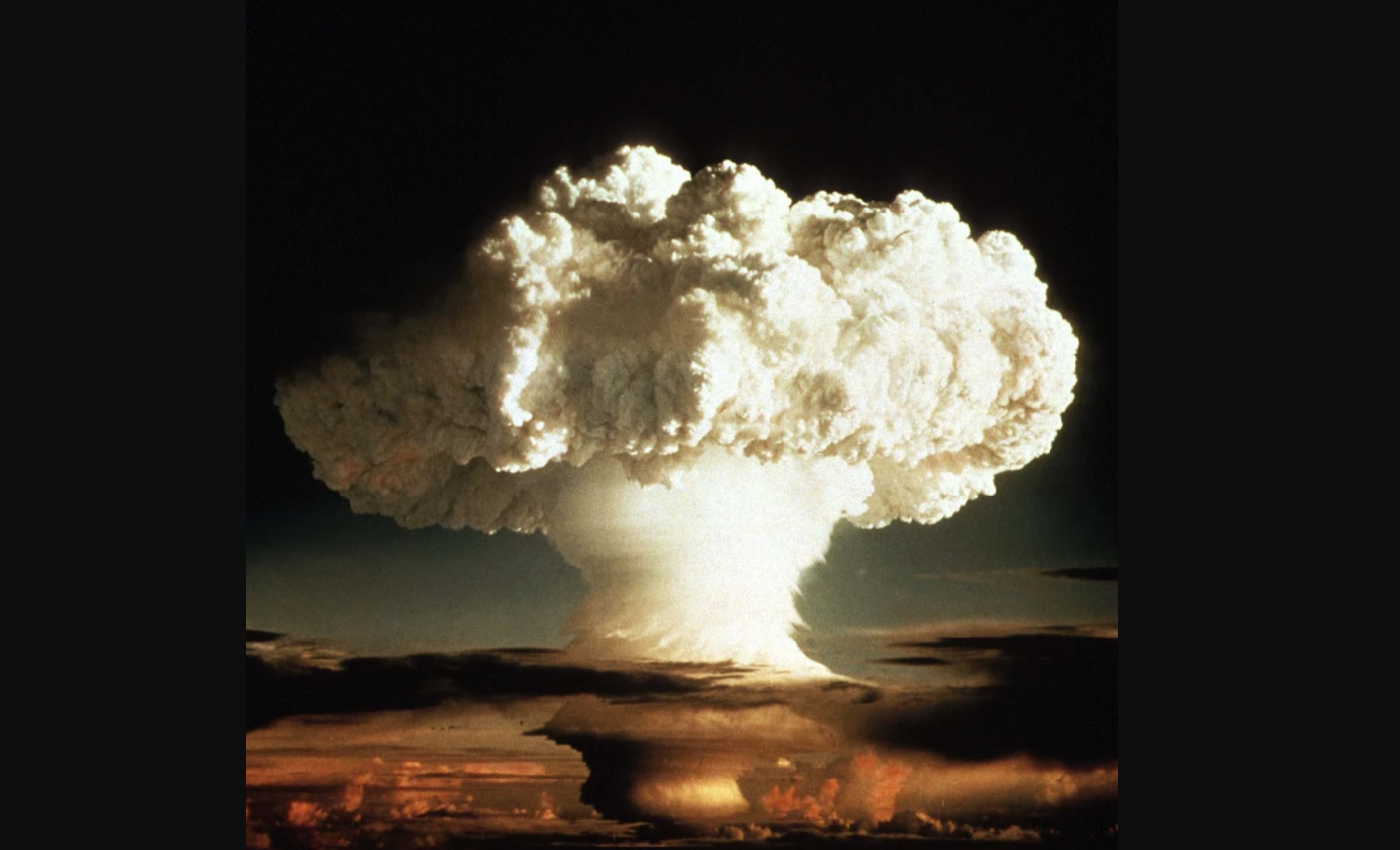

Cosmox Blogs
Hydrogen Bombs: Unleashing The Ultimate Destruction
You might have heard of nuclear weapons and their unprecedented and destructive power as Oppenheimer the Prometheus himself gave humanity the power to destroy themselves, also the man whose invention shook the earth. Christopher Nolan’s masterpiece, Oppenheimer a biopic on the father of the atomic bomb shows us how a nuclear weapon can cause mass destruction and holds the power to wipe out humans in the blink of an eye.
So what is a hydrogen bomb?
Hydrogen bombs, also known as thermonuclear bombs, represent the pinnacle of nuclear weapon technology. These devices are far more powerful than atomic bombs, which rely solely on nuclear fusion. Hydrogen bombs utilize a combination of fission and fusion to unleash an unprecedented level of destruction. This article delves into the history of their creation, the science behind their operation, their catastrophic potential, and their broader implications.
The Historical Genesis
The Atomic BombsThe development of the hydrogen bomb is deeply rooted in the history of nuclear weapons, which began with the atomic bomb during World War II. The atomic bombs dropped on Hiroshima and Nagasaki in 1945 marked the first use of nuclear weapons, leading to Japan's surrender and the end of the war. These bombs relied on nuclear fission, where the nucleus of an atom splits into smaller parts, releasing a tremendous amount of energy.
The Birth of the Hydrogen Bomb
The concept of the hydrogen bomb was initially theorized during the Manhattan Project, the same effort that produced the atomic bomb. Key figures like Edward Teller and Stanislaw Ulam were instrumental in the development of the hydrogen bomb. The first successful test, codenamed "Ivy Mike," was conducted by the United States on November 1, 1952, at Enewetak Atoll in the Pacific Ocean. This test demonstrated the feasibility of a thermonuclear explosion, ushering in a new era of nuclear weapons.
The Teller - Ulam Design:
The Early design of one of the first Hydrogen Bombs was called The Teller - Ulam Design in the technical term. So the idea was that the hydrogen could be chained together in stages with each small detonation triggering and adding up to the ignition of successive stages which could release power equivalent to not kilotons but megatons, just like small dominos falling and triggering bigger ones. To trigger a fusion reaction a miniature fission bomb was inserted in the design to compact the hydrogen atoms together and achieve pressure high enough to induce a fusion reaction.
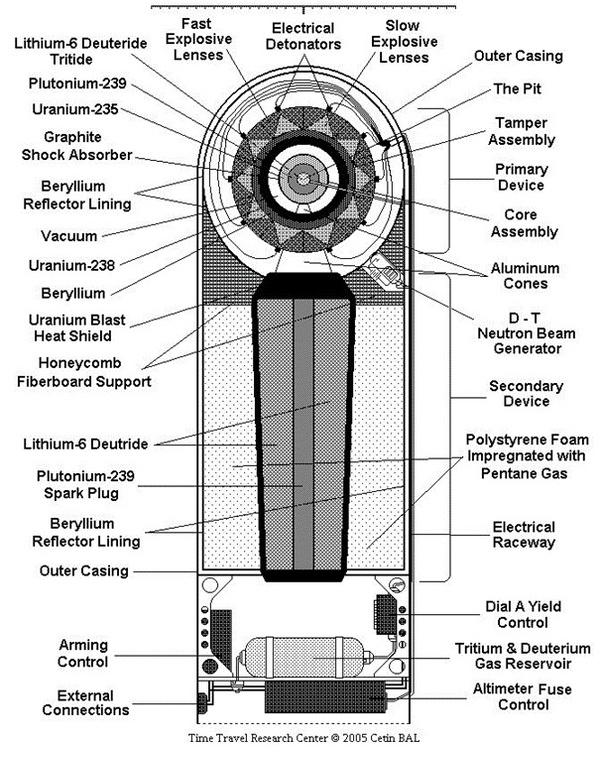 Detonation Stages
Detonation Stages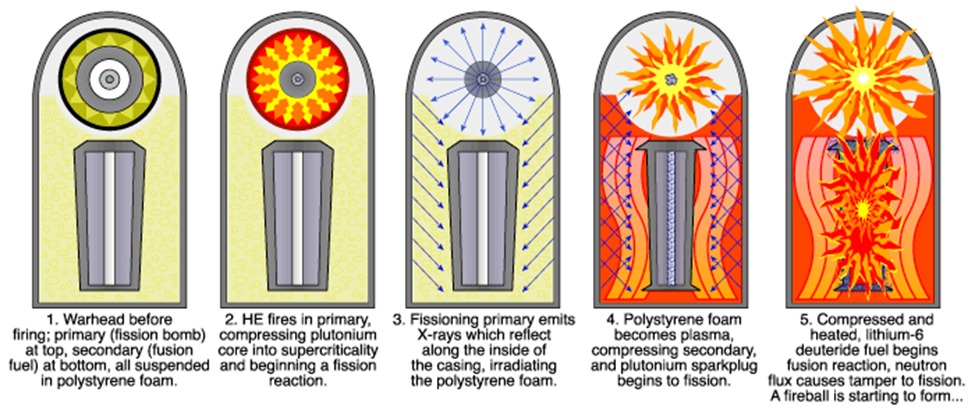
As you can see in the previous and this diagram, how the explosive lenses trigger the plutonium - 239 core and as the miniature bomb fully detonates which releases high amounts of X - Rays and other forms of nuclear radiations which along the inside of external casing irradiating the polystyrene foam which gets converted to plasma compressing the internal Uranium - 235 core and sparkplug which induces fission reaction and finally high pressure and temperature is achieved and Lithium - 6 deuteride fuel begins a fusion reaction. Neutron flux causes the neutrons that split from individual atoms during fission to slow down which increases the probability of it hitting other atoms nucleus to tamper to fission. A fireball starts to form and the chain of disaster is now complete.
The Science Behind Hydrogen BombsNuclear Fusion
The hydrogen bomb's primary mechanism is nuclear fusion, the process that powers the sun. In fusion, light atomic nuclei combine to form a heavier nucleus, releasing energy. In a hydrogen bomb, isotopes of hydrogen-deuterium and tritium are fused together under extreme pressure and temperature, producing a massive explosion.
The Two-Stage Process A typical hydrogen bomb operates through a two-stage process:
1. Primary Stage (Fission Bomb): The bomb starts with a conventional fission bomb, similar to those dropped on Hiroshima and Nagasaki. When detonated, this fission bomb generates immense heat and pressure.
2. Secondary Stage (Fusion Bomb): The heat and pressure from the primary explosion compress a secondary section containing fusion fuel (deuterium and tritium). This compression ignites the fusion reaction, leading to an even larger explosion.
The efficiency of this process can be further enhanced by incorporating a third stage or by using various techniques to increase the compression of the fusion fuel.
Power and Destruction
Comparative Power
Hydrogen bombs are significantly more powerful than their atomic counterparts. While atomic bombshave yields measured in kilotons (thousands of tons of TNT), hydrogen bombs have yields measured in megatons (millions of tons of TNT). For example, the "Tsar Bomba," the most powerful hydrogen bomb ever detonated by the Soviet Union in 1961, had a yield of about 50 megatons, roughly 3,300 times more powerful than the Hiroshima bomb.

The Tsar Bomba:
The United States had Ivy Mike and Castle Bravo which had yielded up to 15 megatons, the USSR had Tsar Bomba the most powerful weapon ever created and conceived by humanity this beast had a yield of about 100 megatons but for test purposes, it was watered down to 50 megatons which is just half of its power. The Soviet physicist Andrei Sakharov oversaw the project at Arzamas-16, while the main work of design was by Sakharov, Viktor Adamsky, Yuri Babayev, Yuri Smirnov, and Yuri Trutnev. The project was ordered by Nikita Khrushchev in July 1961 as part of the Soviet resumption of nuclear testing after the Test Ban Moratorium, with the detonation timed to coincide with the 22nd Congress of the Communist Party of the Soviet Union.
The test verified new design principles for high-yield thermonuclear charges, allowing, as its final report put it, the design of a nuclear device "of practically unlimited power".
The bomb was tested on 30 October 1961 and was dropped with the help of a parachute to give the Tu-95V aircraft and the pilot in it enough time to escape the blast after all that the pilot and the crew had a mere 50% chance of surviving the explosion and as they held their breaths and were on the verge of life or death decided by fate, tsar detonated 4000 meters above the ground of the Novaya Zemlya island and with a power of 50 megatons the explosion was seen from 1000 km away in Norway, Greenland, and Alaska.
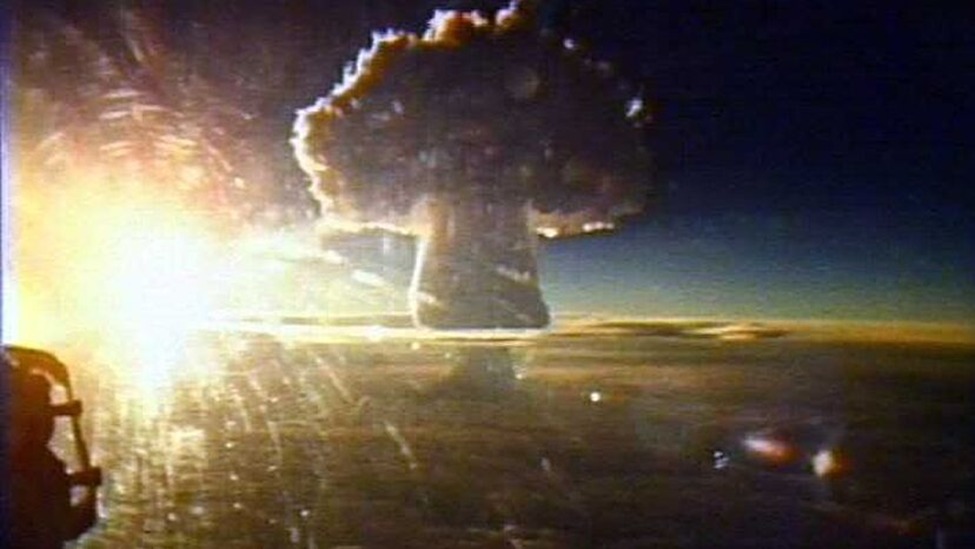
The mushroom cloud rose to a height of 67 km which is 7.5 times the height of mount everest. Witnessing such a cataclysmic scenery a Soviet cameraman in the aircraft said:
“The clouds beneath the aircraft and in the distance were lit up by the powerful flash. The sea of light spread under the hatch and even clouds began to glow and became transparent. At that moment, our aircraft emerged from between two cloud layers, and down below in the gap a huge bright orange ball was emerging. The ball was powerful and arrogant like Jupiter. Slowly and silently it crept upwards ... Having broken through the thick layer of clouds it kept growing. It seemed to suck the whole Earth into it. The spectacle was fantastic, unreal, supernatural."
Catastrophic Effects
The detonation of a hydrogen bomb would result in catastrophic consequences:
1. Immediate Blast: The initial explosion generates an intense shockwave, obliterating everything within a radius of several kilometers. Buildings, infrastructure, and life forms in this area are instantaneously vaporized or severely damaged.
2. Thermal Radiation: The explosion emits a blinding flash of light and heat, causing severe burns and igniting fires over a vast area. The thermal radiation can cause third-degree burns many kilometers from the epicenter.
3. Fallout: Radioactive debris is propelled into the atmosphere, eventually falling back to Earth as radioactive fallout. This fallout contaminates air, water, and soil, posing long-term health risks such as cancer and genetic mutations.
4. Electromagnetic Pulse (EMP): A high-altitude detonation can produce an EMP, disrupting electronic devices and communication systems over a large area, leading to widespread technological failures.
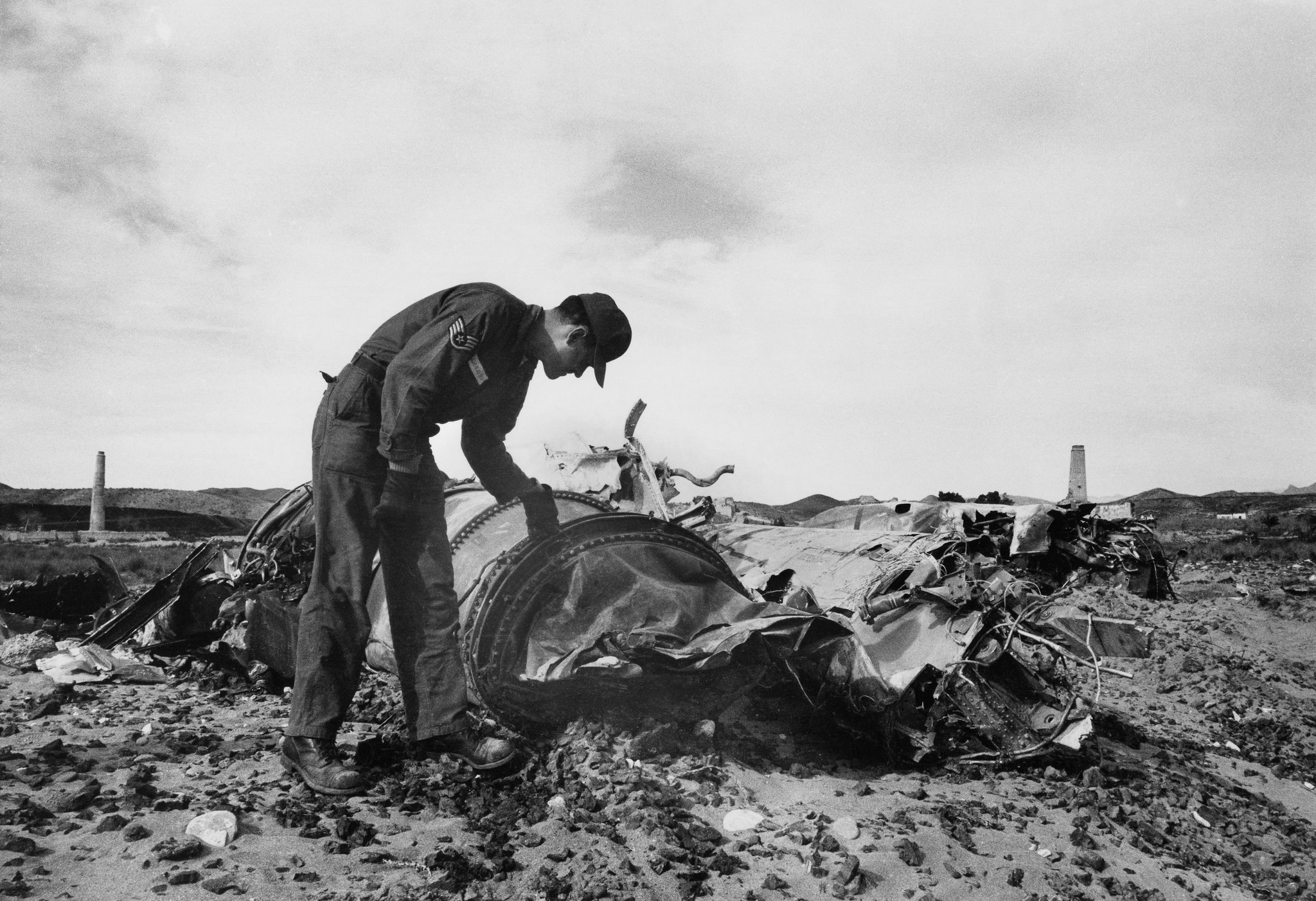
Countries that have acquired hydrogen bombs:
Currently, only six countries in the world have hydrogen bombs which are

Implications and Legacy
Cold War Arms Race
The development of the hydrogen bomb intensified the arms race during the Cold War. Both the United States and the Soviet Union amassed vast arsenals of these weapons, leading to a precarious balance of power known as "Mutually Assured Destruction" (MAD). The mere existence of hydrogen bombs created a deterrent effect, as their use would result in the total annihilation of both the attacker and the defender.
Nuclear Non-Proliferation
In response to the proliferation of nuclear weapons, international treaties such as the Nuclear Non-Proliferation Treaty (NPT) were established to prevent the spread of nuclear weapons and promote disarmament. Despite these efforts, several nations still possess hydrogen bombs, and the threat of nuclear warfare remains a significant global concern.
Modern-Day Context
Today, the specter of hydrogen bombs continues to influence international relations. Nations with nuclear capabilities maintain these weapons as a deterrent, while global efforts persist to reduce and eventually eliminate nuclear arsenals. Advances in technology have also led to the development of more sophisticated and precise delivery systems, further complicating the global security landscape.
Conclusion
Hydrogen bombs represent the apex of destructive power developed by humanity. The entire world has 12,119 nuclear weapons in total. Their creation marked a pivotal moment in history, demonstrating the profound and terrifying capabilities of nuclear technology. While their existence has arguably prevented large-scale conflicts through deterrence, the potential for catastrophic consequences underscores the urgent need for continued efforts in nuclear disarmament and non-proliferation. Understanding the history, science, and impact of hydrogen bombs is crucial in navigating the complex challenges they pose in the modern world.

Cosmox Blogs
A non profit organization that works on writing and delivering blogs on cosmology, natural sciences & environment, so that people can learn more about it. We even run a forums page, where our users interacts with each other and discuss about Cosmology, Natural Sciences & Astronomy. We even run an instagram and a youtube channel with podcasts.